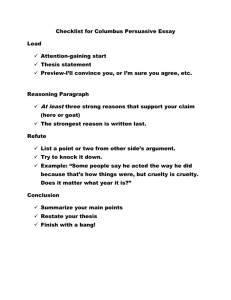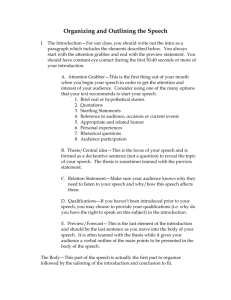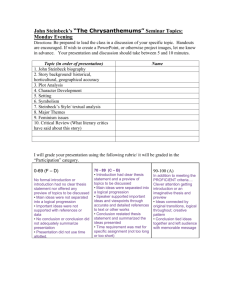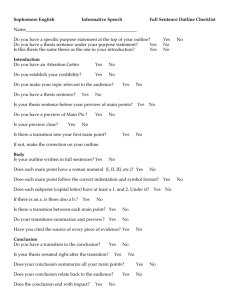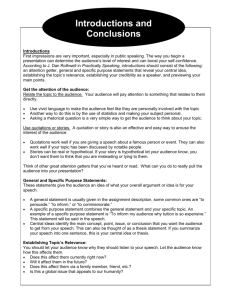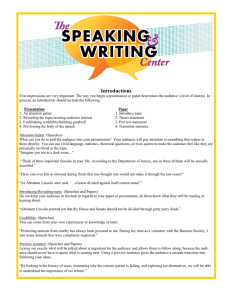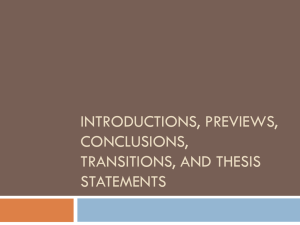Introductions and Conclusions
advertisement
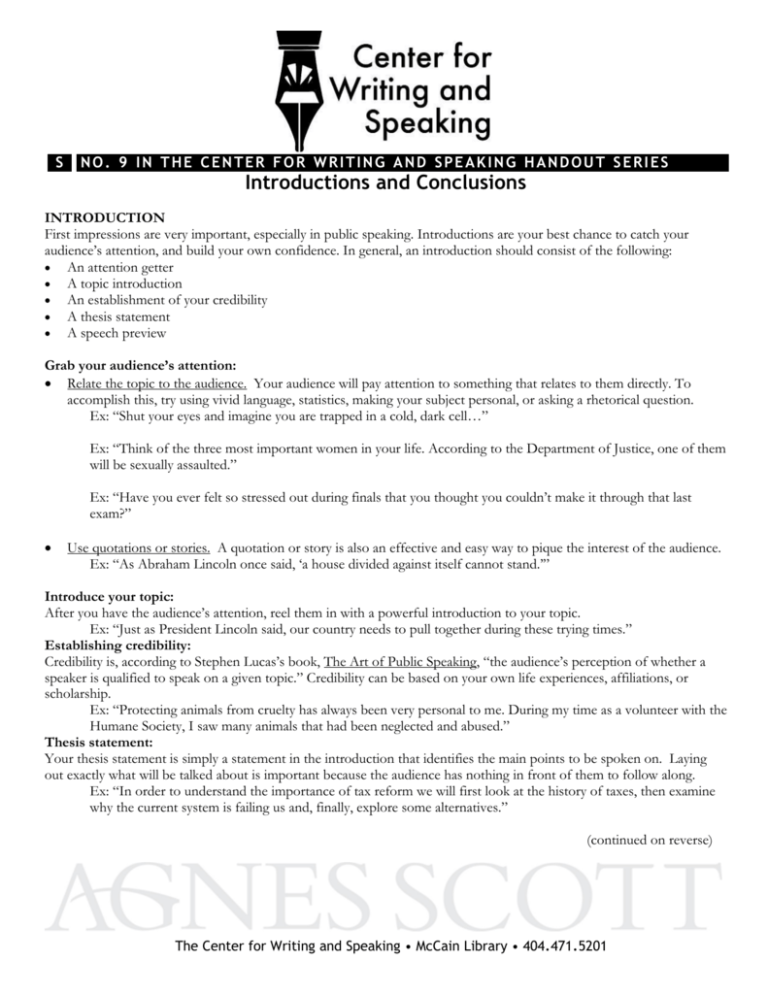
S NO. 9 IN THE CENTER FOR WRITING AND SPEAKING HANDOUT SERIES Introductions and Conclusions INTRODUCTION First impressions are very important, especially in public speaking. Introductions are your best chance to catch your audience’s attention, and build your own confidence. In general, an introduction should consist of the following: An attention getter A topic introduction An establishment of your credibility A thesis statement A speech preview Grab your audience’s attention: Relate the topic to the audience. Your audience will pay attention to something that relates to them directly. To accomplish this, try using vivid language, statistics, making your subject personal, or asking a rhetorical question. Ex: “Shut your eyes and imagine you are trapped in a cold, dark cell…” Ex: “Think of the three most important women in your life. According to the Department of Justice, one of them will be sexually assaulted.” Ex: “Have you ever felt so stressed out during finals that you thought you couldn’t make it through that last exam?” Use quotations or stories. A quotation or story is also an effective and easy way to pique the interest of the audience. Ex: “As Abraham Lincoln once said, ‘a house divided against itself cannot stand.’” Introduce your topic: After you have the audience’s attention, reel them in with a powerful introduction to your topic. Ex: “Just as President Lincoln said, our country needs to pull together during these trying times.” Establishing credibility: Credibility is, according to Stephen Lucas’s book, The Art of Public Speaking, “the audience’s perception of whether a speaker is qualified to speak on a given topic.” Credibility can be based on your own life experiences, affiliations, or scholarship. Ex: “Protecting animals from cruelty has always been very personal to me. During my time as a volunteer with the Humane Society, I saw many animals that had been neglected and abused.” Thesis statement: Your thesis statement is simply a statement in the introduction that identifies the main points to be spoken on. Laying out exactly what will be talked about is important because the audience has nothing in front of them to follow along. Ex: “In order to understand the importance of tax reform we will first look at the history of taxes, then examine why the current system is failing us and, finally, explore some alternatives.” (continued on reverse) The Center for Writing and Speaking • McCain Library • 404.471.5201 S NO. 9 IN THE CENTER FOR WRITING AND SPEAKING HANDOUT SERIES Introductions and Conclusions, Continued Preview: Like your thesis, a preview examines what the speaker will address in the speech. The preview is an articulation of the presentation’s main points. Ex: “First, I will talk about the history of Peta, then I will explain their impact in Atlanta, and then call on you to donate.” CONCLUSION Your conclusion will often be the only part of you speech that the audience remembers. Therefore, the conclusion must be well planned out. A conclusion serves three purposes: To give the audience one last opportunity to understand the material. To provide the audience with a course of action. To let the audience know that the speech is ending. Ask yourself this: What do you want the audience to walk out of the room remembering? That should help determine your concluding remarks Understanding the material: This is best accomplished through a summary statement. Restating the main points synthesizes the information (as well as your arguments) for your audience. Ex: “As we’ve seen during our examination of animal cruelty laws, there are many reasons an animal might be harmed, the majority of which are avoidable. These reasons include the maturity of pet owners, cultural ideas about pets, and other circumstances, like the owner’s death.” Course of Action: Here is your chance to take your speech to the next level and really make it count. Tell your audience what they can do with their new found knowledge. Ex: “Things don’t have to stay this way. If what I have said about domestic violence has moved you, donate your time or money to the local domestic violence shelter, and help make things a little better.” Ex: “Now that you know a little bit about the macrobiotic life forms in our pond, why not go to gogreen.com to learn ways to take advantages of their fertilization properties.” Ending the speech: Be this point in your speech, you have said what you need to and you just need to make a clean exit. Saying something simple, such as “In conclusion,” “In closing,” or “Let me end by saying” gives you a graceful and clear way to end your speech. Remember, linking back to your introduction is an easy way to make your speech seem more polished and well planned. Ex: “In conclusion, Abraham Lincoln’s quote concerning a house divided is especially important in our current time. We can no longer expect to run a country effectively when we are fighting over trivial and meaningless issues. Until politicians realize this, we will never be able to make any changes in the world.” The Center for Writing and Speaking • McCain Library • 404.471.5201
